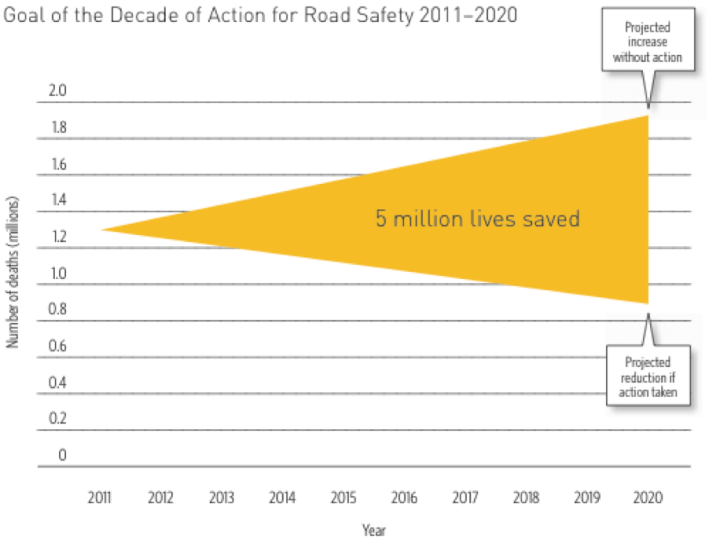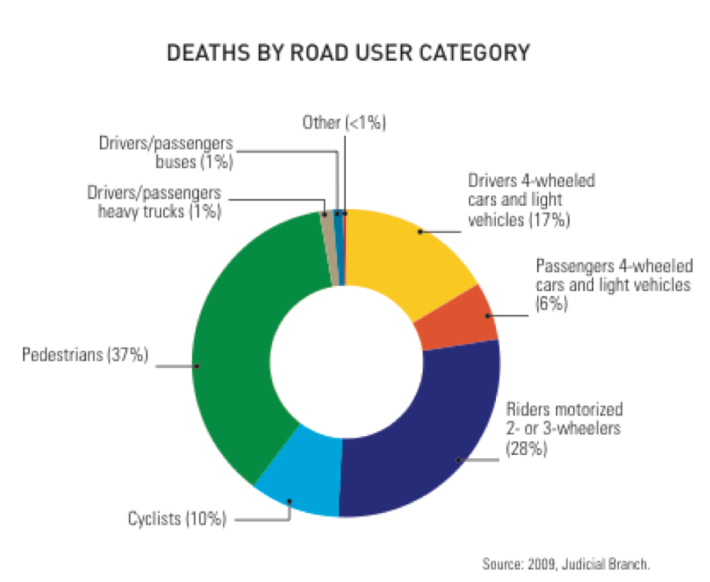
As poorly as America performs on street safety compared to places like Germany, the UK, Japan, and the Netherlands, traffic violence is an even graver public health threat in most other countries. Despite the fact that Africa has fewer cars per person than any other continent, for instance, no other suffers from a worse traffic fatality rate. Each year, 24 out of every 100,000 Africans are killed in traffic, with 38 percent of those deaths being pedestrians.
Globally, 1.24 million people die in traffic crashes each year. Fewer than a third of them are in a car when the crash happens. Half of the victims are either on foot (22 percent), on a bicycle (5 percent), or on a motorcycle (23 percent). In the language of street safety research, these people are "vulnerable road users" or "non-occupants." Another 19 percent of road deaths are among "unspecified road users."

As car ownership rises in developing countries -- the places already plagued with the worst level of traffic violence -- the United Nations has declared 2011-2020 a "Decade of Action for Road Safety." In low- and middle-income countries, 84 percent of roads where pedestrians are present have no safe place for them to walk.
Without action, traffic fatalities are projected to rise to 1.9 million by the end of the decade, but the UN hopes to "stabilize and reduce" traffic deaths to about 900,000 by 2020.
In a report released last year, the UN and the World Health Organization framed safety for walking and biking as an important corrective to the global growth in car ownership:
As the world continues to motorize, walking and cycling need to be made safe and promoted as healthy and less expensive mobility options. However, only 68 countries have national or subnational policies to promote walking and cycling, and just 79 countries have policies that protect pedestrians and cyclists by separating them from motorized and high-speed traffic.
The UN now grades countries according to five "pillars of action" for road safety:
Each country gets a scorecard on its performance in these five areas. Policies to design safer streets and promote walking, biking, and transit fit under Pillar 2. The International Road Assessment Programme, which sets standards for road safety performance, considers street safety audits “vaccines for roads.”
International Automobile Federation President Jean Todt recently lamented that while over 100 countries supported the launch of the Decade of Action, many still do not take road safety seriously enough. But the campaign is beginning to have an impact.
Uganda and several other sub-Saharan countries are setting up road safety authorities, as the UN has recommended. Bella Dinh-Zarr, North America director of the Make Roads Safe campaign and co-chair of the UN NGO Committee on Sustainable Development, says that Costa Rica has improved its bicycle infrastructure and worked with the police to improve traffic enforcement. Vietnam, which has shifted from widespread bicycle use to motorcycles, is working to separate motorbikes from cars in rural areas and to separate pedestrians from motorcycles and cars in urban ones. Vietnam is also working on a tropical-weight helmet to try to address a primary reason many people don’t want to wear one.
Though the UN doesn’t put financial resources behind its recommendations, Dinh-Zarr says development banks fund projects that align with UN goals, and that the focus on vulnerable users could encourage these banks to change their ways, too. “It’s important for the governments themselves to say, ‘We need funding for safe roads, not just for roads,’” Dinh-Zarr said. “Because that’s the problem. [The multinational development banks] are building $4 billion of roads every year, but they’re building them longer and faster at the expense of being safe.”
The Decade of Action came about as a result of advocacy from around the world. Nelson Mandela’s family has lost two members to motor vehicle crashes -- his son was killed while Mandela was in prison, and in 2010 his 13-year-old great-granddaughter was killed on her way to see the World Cup. Both were in vehicles, but the Mandelas knew that most African children killed in traffic are pedestrians. They started the Long Short Walk campaign, calling for the UN to make road safety a development goal.
Pressure came from many directions. Oman’s ambassador to the UN made it a personal mission. George Robertson, a British former secretary general of NATO and car crash survivor, has also been an advocate. The Make Roads Safe Campaign collected a million signatures and pictures of people holding up signs asking for the UN to launch a Decade of Action.“[The UN] has a lot of other efforts related to reducing deaths -- for example, the Decade to Roll Back Malaria,” said Dinh-Zarr. “But this is different in the sense that it’s not an infectious disease; it’s not a chronic disease. It’s the first time motor vehicle related injuries and deaths were addressed by the UN as an official goal.”
But with road deaths poised to overtaken HIV/AIDS deaths around the world soon, the UN took action. “That’s what we have vaccines for,” said Dinh-Zarr. “We’ve really protected these children zero to five years old through vaccines. There are still too many children dying but we’ve made great gains. But then at 5 years old, we put them on the road to go to school, and we kill them.”






